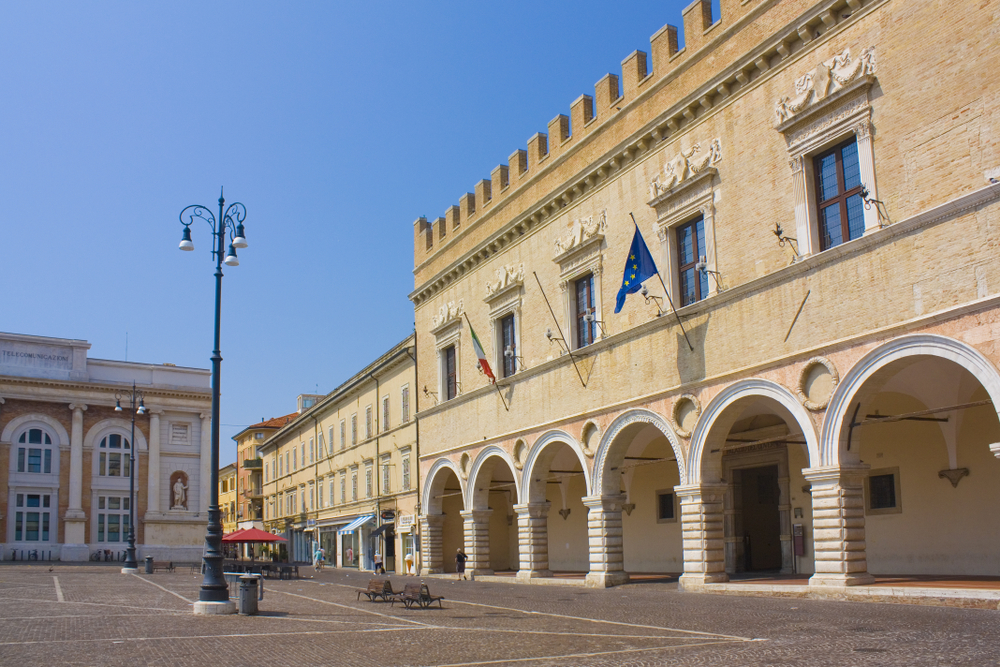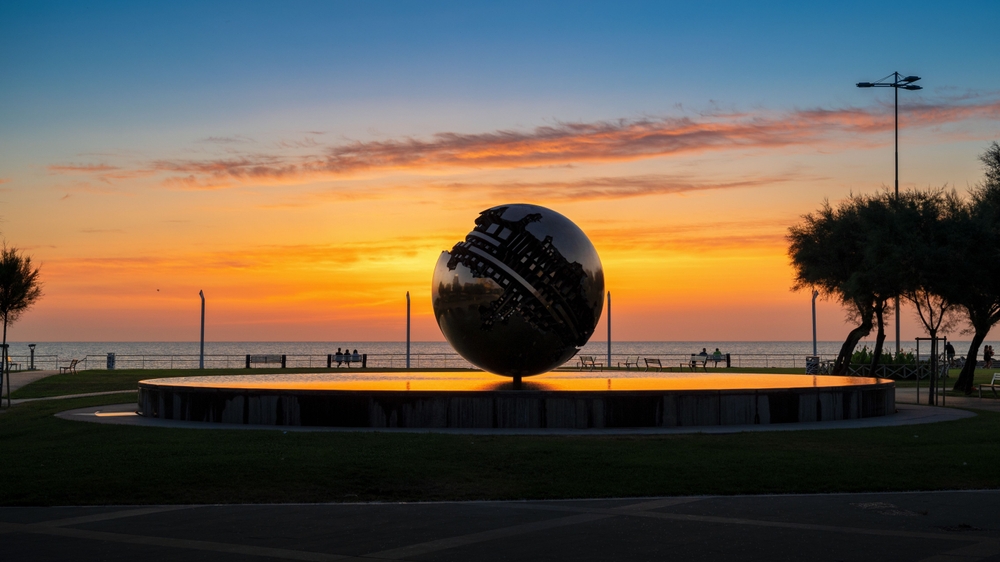Guide to Pesaro: Pesaro travel guide
Overlooking the Adriatic sea and crossed by the River Foglia, Pesaro is a seaside resort located between two coastal hills. These are Monte Ardizio to the east-southeast and Monte San Bartolo to the west-northwest. Incidentally this mountain gives its name to the Monte San Bartolo Natural Park.
Pesaro is the Italian Capital of Culture for 2024. This city in the north of the Marche region beat rivals including Ascoli Piceno, Grosseto, Siracusa and Viareggio to claim this elusive title. It’s not the first time Pesaro has received an award though. In 2017, Pesaro was recognised by UNESCO as a creative city for music. It was given this title thanks to Pesaro’s promotion and revival of Rossini’s music. Pesaro was actually the birthplace of the famous composer Gioachino Rossini, who was born in Pesaro in 1792 and died in Passy in Paris in 1868.
Pesaro is certainly deserving of this latest award. A charming town, it is the perfect destination for anyone looking to take full advantage of the Le Marche region. Despite its smaller size compared to many of Italy’s other cultural hotspots, it has become increasingly popular in recent years.
During the summer months, the town comes alive, with locals and tourists alike flocking to the surrounding beaches to cool off.

Pesaro’s medieval centre also sees its fair share of excitement during the peak months. However, the peak summer temperatures may actually be slightly uncomfortable for some travellers. Don’t worry though. The city’s Mediterranean climate results in warm temperatures that often extend long into the autumn months, perfect for a last-minute October getaway.
What to see and do in Pesaro
A good starting point for any visit to Pesaro is it’s centro storico. Whilst having originally been established as a Roman colony dating as far back as the 2nd century BC, most of Pesaro’s architecture stems from the 13th and 14th centuries when it was owned by the Malatesta family. Like many other towns in the region, Pesaro’s old town is an enchanting blend of large open piazza’s and quaint side streets, often littered with bars and restaurants. A leisurely stroll through this historic city is the perfect way to spend an afternoon, and an aperitif at one of the city’s stylish bars is undoubtedly a great way to relax before dining at a local osteria. These serve up a variety of simple but tasty dishes, coupled with a local wine from the surrounding hills.
Located in the heart of Pesaro lies the Palazzo Ducale, a renaissance-style palace with the original structure estimated to date back as far as 1285 AD, having been commissioned by Malatesta family.

Its current façade was constructed in the 15th century, and has been extensively refurbished multiple times, most recently in the 19th century. Thanks to the city’s cultural significance, the palace also often hosts art exhibitions and cultural events inside its walls, creating an unforgettable spectacle for any visitor lucky enough to take part.
Many visit Pesaro because of their interest in music and in Rossini, the composer of the Barber of Seville. For those that do, a tour of Casa Rossini where he once lived is a must. It contains memorabilia relating to his life, whilst you will his piano and original manuscripts in the Conservatorio Rossini. It’s because of Rossini that Pesaro has earned itself the nickname of being the ‘city of music.’.
However, Rossini is not the only famous resident of Pesaro. Pesaro was also the birthplace of Valentino Rossi. Rossi was the nine-time Grand Prix motorcycle racing World Champion. For motorbike enthusiasts, Pesaro is home to a couple of motorbike museums – the Moribidelli museum and the Benelli museum.
And Pesaro has another nickname besides being the city of music. It’s also affectionately known as the city of bicycles thanks to the kilometres of bike paths that characterise the city. The bicipolitana is a route reserved for cyclists and which connects different parts of the city. Signposts clearly indicate the different routes, with different coloured lines leading cyclists in a plethora of different directions.
Other Pesaro highlights include the fountain in the Piazza del Popolo and the Duomo – the Cattedrale di Santa Maria Assunta. We would be lying if we said that the cathedral in Pesaro was spectacular. However, it is definitely well worth a visit. Use a coin to operate the lights that will reveal the amazing pre Christmas mosaic floors.

The duomo is not the only church in Pesaro. We would also recommend that you head inside the Church of Sant’ Agostino on the Corso XI Settembre. The choir stalls inside are well worth seeing, inlaid with landscapes and narrative scenes.
There are also some fantastic museums in Pesaro too. Head to the Musei Civici to admire Giovanni Bellini’s Coronation of the Virgin polyptych dating to 1470 along with a collection of Renaissance ceramics. In addition there is the Museo Archeologico Oliveriano in Pesaro. Here there are displays of Roman remains and Iron Age finds discovered in the nearby necropolis at Novilara.
If you’re visiting during the Summer months, then the Adriatic sea is the perfect place for anyone looking to cool off. Pesaro’s coastline is often regarded as some of most picturesque in Le Marche, if not Italy. It is well-known for its chilled beach clubs and golden sandy beaches that are popular among locals. The man-made breakwaters situated just off the coast protect the shoreline from tides, currents, and large swells, making it the perfect place for a relaxing swim. After a long day of sunbathing and swimming, the many bars and restaurants that litter the coastline can be the perfect way to socialise and wind down in the evening. Incidentally, whilst you are beachfront, look out for the art installation by Arnaldo Pomodoro, a terrestrial globe open in half with gears inside it, which is meant to represent the union between man and nature.

Finally, no visit to Pesaro would be complete without a visit to the nearby Rocca Costanza, a massive 14th century military fortress in Gradara, or to the San Bartolo natural park. Just a short drive from Pesaro’s historic centre, this park is best known for its dramatic cliffs that give way to the Adriatic sea. Its highest peak, Mount San Bartolo, is just 222m high, but beautifully juxtaposes the rugged terrain with the idyllic water below to provide visitors with some of the most breath-taking views in the region. With twenty unique hiking trails designed to cater to all levels of ability, the park is perfect for anyone looking to take in the area from a different perspective. If you’re travelling to the area during the peak summer months, our recommendation is to visit the park early in the morning to avoid the soaring temperatures and to take advantage of the quieter trails.
Events in Pesaro
Held every year in August, the Rossini Opera Festival is renowned worldwide and celebrates the 18th century composer Gioachino Rossini, who was born in the city in 1792. The festival predominantly revolves around the performances given in the Teatro Rossini, which was constructed in honour of the composer in 1818. The festival was originally created in 1980 with the intention of drawing attention to the somewhat neglected works of the composer. The festival has since received international acclaim, with around 20,000 spectators flocking to the city every year to watch over fifty unique performances.
Earlier in the year, Pesaro also hosts the Mostra Internazionale del Nuovo Cinema (Pesaro film festival). This is one of Italy’s most important film festivals and takes place each June.
Local Cuisine of Pesaro
A trip to Italy wouldn’t be complete without tasting some of the exquisite cuisine the country has to offer. Due to its proximity to the Adriatic sea, the Le Marche region has a rich maritime history, and this is still reflected in many marchigian dishes today. Many regular visitors to Italy will be well-accustomed to the simple yet delicious Tagliatelle al Tartufo. This dish, a speciality of Tuscany, Umbria, and Piedmont, is also commonly found in many of Le Marche’s restaurants. When combined with a refreshing glass of Verdicchio (a popular white wine that originally stems from the Le Marche region), this dish can be the perfect way to enjoy a lighter lunch or dinner in the sunshine. The region’s speciality, however, is Vincigrassi, a layered pasta dish similar to lasagne, but instead uses either chicken or pork offal to enhance the flavour. It is found throughout Le Marche, and many of Pesaro’s restaurants still serve the historic dish to this day.

How to get to Pesaro
By train: Pesaro has a train station, located within a 25 minute walk of the beachfront in Pesaro.
By car: There are plenty of car parks in Pesaro, making it easy for those coming to Pesaro by car.
By boat: There is a ferry port in Pesaro. There are two parallel docks, one for ferries and one for recreational boats.
By plane: The nearest airport to Pesaro is in Rimini which is approximately 30 minutes away by car.
For anyone looking to take full advantage of Italy’s warm Mediterranean climate, Pesaro is the perfect destination. Its medieval old town and rich cultural history, combined with the town’s proximity to the Adriatic sea gives Pesaro a unique appeal that is often favoured over some of Italy’s larger landlocked cultural hotspots.


